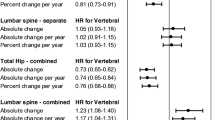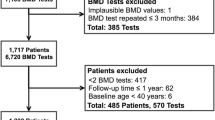Abstract
We calculated how long to wait before repeating bone mineral density (BMD) measurements to reassess fracture risk. Correlation results from serial measurements of 495 postmenopausal Japanese-American women were used to estimate 95% confidence intervals (CI) for future BMD. After 7 years of follow-up, BMD correlations with the initial measurement ranged between 0.81 and 0.94, depending on age group and measurement site. In this analysis, the period between measurements was defined as the time required for the lower 95% CI to fall below the BMD value corresponding to doubling of fracture risk. Progressive bone loss causes fracture risk to double after 10 years, on average. However, the 95% CIs indicate that a second BMD measurement will detect risk doubling after only 2 or 3 years for some women. For untreated, early postmenopausal women, the period between measurements was approximately 2–5 years for the radius and 4–6 years for the calcaneus, depending on the initial BMD level. The period was approximately 1 year longer for women age 60 and older. Treatments that halve the bone loss rate would increase the period by 1–3 years. In the absence of a second measurement of BMD, the CI will continue to expand with time, corresponding to a wider range in risk between individuals, and a greater proportion of women will be at increased fracture risk. Obtaining a second BMD measurement pinpoints the patient's status within the precision of the measurement. We conclude that repeated BMD measurements will provide a more accurate estimate of fracture risk than a single, baseline measurement.
Similar content being viewed by others
References
Wasnich RD, Ross PD, Heilbrun LK, Vogel JM (1985) Prediction of postmenopausal fracture risk with bone mineral measurements. Am J Obstet Gynecol 153:745–751
Ross PD, Wasnich RD, Heilbrun LK, Vogel JM (1987) Definition of a spine fracture threshold based upon prospective fracture risk. Bone 8:271–278
Wasnich RD, Ross PD, MacLean CJ, Vogel JM, Davis JW (1989) A comparison of single versus multi-site BMC measurements for assessment of spine fracture probability. J Nucl Med 30:1166–1171
Hui SL, Slemenda CW, Johnston CC Jr (1989) Baseline measurement of bone mass predicts fracture in white women. Ann Intern Med 111:355–361
Gardsell P, Johnell O, Nilsson BE (1989) Predicting fractures in women by using forearm bone densitometry. Calcif Tissue Int 44:235–242
Ross PD, Davis JW, Vogel JM, Wasnich RD (1990) A critical review of bone mass and the risk of fractures in osteoporosis. Calcif Tissue Int 46:149–161
Cummings SR, Black D, Nevitt MC, et al. (1990) Appendicular densitometry and age predict hip fracture in women. JAMA 263:665–668
Seeley DG, Browner WS, Nevitt MC, Genant HK, Scott JC, Cummings SR (1991) Which fractures are associated with low appendicular bone mass in elderly women? Ann Intern Med 115:837–842
Black DM, Cummings SR, Genant HK, Nevitt MC, Palermo L, Browner W (1992) Axial and appendicular bone density predict fractures in older women. J Bone Miner Res 7:633–638
Ross PD, Davis JW, Epstein R, Wasnich RD (1991) Pre-existing fractures and bone mass predict vertebral fracture incidence. Ann Intern Med 114(11):919–923
Ross PD, Genant HK, Davis JW, Miller P, Wasnich RD (1993) Predicting vertebral fracture incidence from prevalent fractures and bone density among non-black, osteoporotic women. Osteoporosis Int 3(3):120–127
Melton LJ III, Atkinson EJ, O'Fallon WM, Wahner HW, Riggs BL (1993) Long-term fracture prediction by bone mineral assessed at different skeletal sites. J Bone Miner Res 8:1227–1233
Wasnich RD, Davis JW, Ross PD (1994) Spine fracture risk is predicted by non-spine fractures. Osteoporosis Int 4:1–5
Melton LJ III, Eddy DM, Johnston CC (1990) Screening for osteoporosis. Ann Intern Med 112:516–528
Davis JW, Ross PD, Wasnich RD, MacLean CJ, Vogel JM (1991) The long-term precision of bone loss rate measurements among postmenopausal women. Calcif Tissue Int 48(5):311–318
Davis JW, Ross PD, Wasnich RD, MacLean CJ, Vogel JM (1989) Comparison of cross-sectional and longitudinal measurements of age-related changes in bone mass. J Bone Miner Res 4:351–357
Hui S, Slemenda C, Johnston C Jr (1990) The contribution of bone loss to postmenopausal osteoporosis. Osteoporosis Int 1: 30–34
Harris S, Dawson-Hughes B (1992) Rates of change in bone mineral density of the spine, heel, femoral neck and radius in healthy postmenopausal women. Bone Miner 17:87–95
He Y-F, Davis JW, Ross PD, Wasnich RD (1993) Declining bone loss rate variability with increasing follow-up time. Bone Miner 21:119–128
Ross PD, Davis JW, Wasnich RD, Vogel JM (1991) The clinical application of serial bone mass measurements. Bone Miner 12: 189–199
He Y-F, Ross PD, Davis JW, MacLean CJ, Epstein RS, Wasnich RD (1992) A method for estimating the uncertainty of future bone mass. Bone 13:243–247
Yano K, Wasnich RD, Vogel JM, Heilbrun LK (1984) Bone mineral measurements among middle-aged and elderly Japanese residents in Hawaii. Am J Epidemiol 119(5):751–764
Heilbrun LK, Kagan A, Nomura A, Wasnich RD (1985) The origins of epidemiologic studies of heart disease, cancer, and osteoporosis among Hawaii Japanese. Hawaii Med J 44:294–296
Heilbrun LK, Ross PD, Wasnich RD, Vogel JM, Yano KY (1991) Characteristics of respondents and nonrespondents in a prospective study of osteoporosis. J Clin Epidemiol 44(3):233–239
Vogel JM (1987) Application principles and technical considerations in SPA. In: HK Genant (ed) Osteoporosis update. University Press, Berkeley, pp 219–231
Hagino H, Yamamoto K, Teshima R, Kishimoto H, Kagawa T (1992) Radial bone mineral changes in pre-and postmenopausal healthy Japanese women: cross-sectional and longitudinal studies. J Bone Miner Res 7:147–152
Davis JW, Ross PD, Vogel JM, Wasnich RD (1990) Postmenopausal estrogen use among Japanese-American women: patterns of use and effects on bone loss rates. In: C Christiansen, K Overgaard (eds) Osteoporosis 1990. Osteopress ApS, Copenhagen, Denmark, pp 1099–1101
Aloia JF, Vaswani A, Yeh JK, Ross PL, Flaster E, Dilmanian FA (1994) Calcium supplementation with and without hormone replacement therapy to prevent postmenopausal bone loss. Ann Intern Med 120:97–103
Quigley MET, Martin PL, Burnier AM, Brooks P (1987) Estrogen therapy arrests bone loss in elderly women. Am J Obstet Gynecol 156:1516–1523
Davis JW, Ross PD, Wasnich RD, Vogel JM (1992) Relationship between bone mineral content and bone loss rate at appendicular skeletal sites. J Bone Miner Res 7(7):719–725
Van Hemert AM, Vandenbroucke JP, Hofman A, Valkenburg HA (1990) Metacarpal bone loss in middle-aged women: “Horse-racing” in a 9-year population-based follow-up study. J Clin Epidemiol 43:579–588
Hansen MA, Overgaard K, Riis BJ, Christiansen C (1991) Role of peak bone mass and bone loss in postmenopausal osteoporosis: 12 year study. BMJ 303:961–964
Garn SM, Sullivan TV, Decker SA, Larkin FA, Hawthorne VM (1992) Continuing bone expansion and increasing bone loss over a two-decade period in men and women from a total community sample. Am J Hum Biol 4:57–67
Wasnich RD, Ross PD, Vogel JM, Davis JW (1989) Osteoporosis. Critique and Practicum. Banyan Press, Honolulu
Suman VJ, Atkinson EJ, O'Fallon WM, Black DM, Melton LJ III (1993) A nomogram for predicting lifetime hip fracture risk from radius bone mineral density and age. Bone 14:843–846
Faulkner KG, Cummings SR, Black D, Palermo L, Gluer CC, Genant HK (1993) Simple measurement of femoral geometry predicts hip fracture: the study of osteoporotic fractures. J Bone Miner Res 8:1211–1217
Lang P, Steiger P, Faulkner K, Gluer C, Genant HK (1991) Osteoporosis: current techniques and recent developments in quantitative bone densitometry. Radiol Clin North Am 29:49–76
Rosner B, Langford HG (1991) Judging the effectiveness of antihypertensive therapy in an individual patient. J Clin Epidemiol 44:831–838
Toronto Working Group on Cholesterol Policy: Naylor CD, Basinski A, Frank JW, Rachlis MM (1990) Asymptomatic hypercholesterolemia: a clinical policy review. J Clin Epidemiol 43: 1029–1121
Author information
Authors and Affiliations
Rights and permissions
About this article
Cite this article
He, Y.F., Ross, P.D., Davis, J.W. et al. When should bone density measurements be repeated?. Calcif Tissue Int 55, 243–248 (1994). https://doi.org/10.1007/BF00310399
Received:
Accepted:
Issue Date:
DOI: https://doi.org/10.1007/BF00310399




